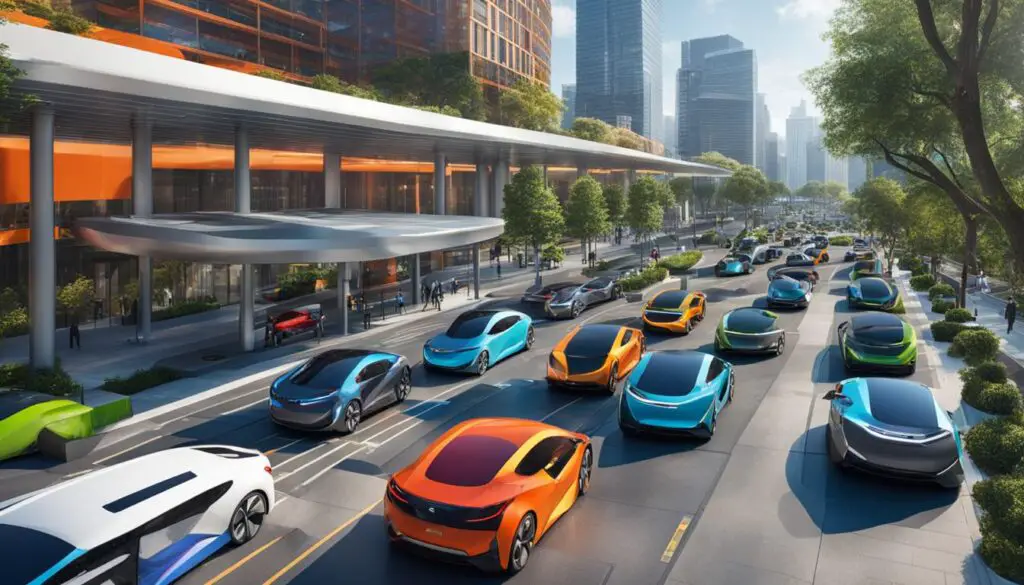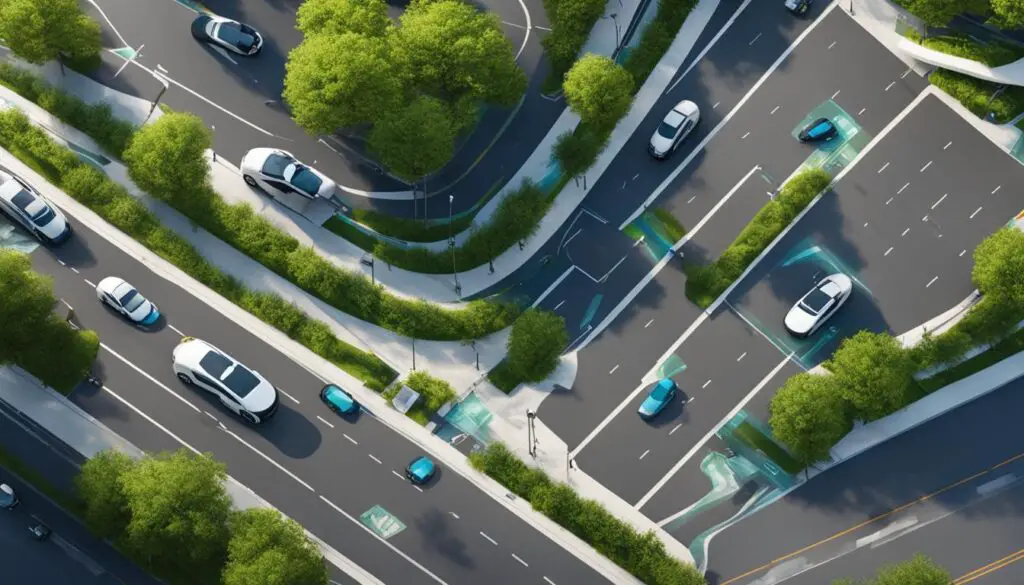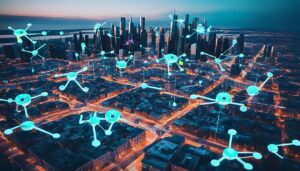
I am excited to explore the incredible potential of Artificial Intelligence (AI) in revolutionizing the transportation industry and providing sustainable solutions that contribute to a greener future. AI technologies offer us the opportunity to optimize transportation operations, reduce fuel consumption, and minimize carbon emissions, thereby creating a more sustainable and environmentally friendly transportation system.
With advancements in AI, we can develop intelligent systems and applications that can analyze data, make accurate predictions, and optimize traffic flow. By leveraging AI-driven smart traffic management systems, we can reduce congestion, minimize travel time, and ultimately decrease the overall carbon footprint of our transportation network. Additionally, AI can accelerate the adoption of electric vehicles (EVs) by optimizing charging schedules, managing peak demand, and balancing the load on the electrical grid. This integration of AI into EV charging infrastructure can significantly enhance the efficiency of electric transportation systems, promoting the use of renewable energy and reducing reliance on fossil fuels.
Another exciting area where AI is making a difference is in the development of autonomous vehicles. Through AI algorithms, self-driving cars can make real-time decisions based on environmental data, traffic conditions, and passenger preferences to optimize routes, reduce fuel consumption, and minimize emissions. Furthermore, the introduction of shared autonomous vehicles can contribute to sustainable mobility by reducing the number of private cars and improving resource utilization.
As we move towards a sustainable future, investing in AI research and development is crucial. Collaborations between industry and academia are essential for driving innovation in sustainable transportation solutions. It is imperative that we prioritize the integration of AI-driven solutions into our transportation infrastructure to create a more sustainable and greener mobility system that benefits the planet and its inhabitants.
Key Takeaways:
- AI has the potential to revolutionize the transportation industry by offering sustainable solutions that can reduce pollution and promote environmental conservation.
- Smart traffic management systems powered by AI can optimize traffic flow, reduce congestion, and minimize travel time and fuel consumption.
- AI integration into EV charging infrastructure can accelerate the adoption of electric vehicles and promote renewable energy integration.
- Autonomous vehicles driven by AI can significantly reduce fuel consumption, emissions, and improve resource utilization through shared mobility.
- Investing in AI research and development and fostering collaboration between industry and academia are crucial for the advancement of sustainable transportation solutions.
AI-driven Smart Traffic Management
Smart traffic management powered by AI is revolutionizing transportation systems, optimizing traffic flow, and reducing congestion. By leveraging real-time data from sensors, cameras, and connected devices, AI algorithms provide accurate predictions, optimize traffic signal timings, and suggest alternative routes for minimizing travel time and fuel consumption.
These intelligent systems adapt to changing traffic patterns, prioritize emergency vehicles, and improve overall traffic efficiency, resulting in a significant reduction in greenhouse gas emissions and a more sustainable transportation network.
How AI Optimizes Traffic Flow
AI-enabled smart traffic management systems analyze vast amounts of data generated by various sources, including:
- Sensors embedded in roads and infrastructure
- Traffic cameras capturing real-time images
- Connected devices providing input on traffic conditions
By processing and analyzing this data in real-time, AI algorithms can make informed decisions to optimize traffic flow and reduce congestion. The benefits of AI-driven smart traffic management systems include:
- Accurate Traffic Predictions: AI algorithms can analyze historical and real-time traffic data to make accurate predictions about future traffic patterns. This enables better planning and optimization of transportation networks.
- Traffic Signal Optimization: By optimizing traffic signal timings based on real-time traffic conditions, AI can ensure that traffic flows smoothly, reducing idle time and minimizing fuel consumption.
- Alternative Route Suggestions: When congestion occurs, AI can suggest alternative routes to drivers, helping them avoid heavily congested areas and saving both time and fuel.
“Smart traffic management systems powered by AI optimize traffic flow, reduce congestion, and create a more sustainable transportation network.”
The Impact on Sustainability
The integration of AI in transportation and traffic management has significant implications for sustainability. By optimizing traffic flow and reducing congestion, smart traffic management systems powered by AI contribute to the following environmental benefits:
- Reduction in Greenhouse Gas Emissions: Efficient traffic flow leads to a decrease in idling time, which in turn reduces carbon emissions and air pollution.
- Fuel Consumption Reduction: AI-driven smart traffic management systems ensure smoother traffic flow, reducing the time spent on the road and minimizing fuel consumption, which is particularly beneficial for reducing reliance on fossil fuels.
- Improved Emergency Vehicle Response: AI algorithms can prioritize emergency vehicles, ensuring quicker response times and potentially saving lives.
| Benefits of AI-driven Smart Traffic Management | Impact on Sustainability |
|---|---|
| Accurate traffic predictions | Reduction in greenhouse gas emissions |
| Traffic signal optimization | Fuel consumption reduction |
| Alternative route suggestions | Improved emergency vehicle response |
Electric Vehicle Integration and Charging Infrastructure Optimization
AI has emerged as a powerful tool in accelerating the adoption of electric vehicles (EVs) and optimizing the charging infrastructure, making sustainable transportation a reality. By leveraging AI algorithms, we can analyze data from EVs, charging stations, and the electrical grid to optimize charging schedules, manage peak demand, and balance the load on the grid.
Integrating AI into EV charging infrastructure offers numerous benefits, including minimizing energy waste, improving overall system efficiency, and reducing reliance on fossil fuels. This optimization allows us to promote the integration of renewable energy sources and pave the way for a greener future.
Optimizing Charging Schedules and Balancing Grid Load
A critical aspect of electric vehicle integration is optimizing charging schedules to meet user demands and balance the load on the electrical grid. AI algorithms can analyze data from various sources, including charging station availability, EV battery levels, and electricity pricing. By considering these factors, AI can recommend optimal charging times, ensuring that EV owners can charge their vehicles conveniently while avoiding peak demand periods.

This optimization not only benefits EV owners but also helps balance the load on the electrical grid. By distributing charging patterns more evenly, AI can prevent strain on the grid during peak periods, reducing the risk of blackouts and ensuring reliable electricity supply for both EVs and other consumers.
Minimizing Energy Waste and Enhancing Efficiency
AI algorithms can also help minimize energy waste and improve the overall efficiency of electric transportation systems. By analyzing data on charging patterns, energy usage, and demand forecasts, AI can optimize the allocation of energy resources, reducing unnecessary energy consumption and enhancing overall efficiency.
“AI-driven optimization of charging infrastructure leads to improved energy efficiency and enhanced utilization of available resources,” says Dr. Maria Johnson, a leading expert on sustainable transportation.
This optimization not only benefits the environment by reducing energy waste but also has economic advantages. By avoiding unnecessary electricity expenses and maximizing the efficiency of EV charging, AI can help reduce the overall cost of electric transportation, making it more accessible and appealing to a wider audience.
Driving Sustainable Transportation Forward
The integration of AI into electric vehicle charging infrastructure plays a vital role in driving sustainable transportation forward. By optimizing charging schedules, balancing grid load, and minimizing energy waste, AI ensures the efficient and widespread adoption of electric vehicles while reducing our reliance on fossil fuels.
With AI-enabled charging infrastructure optimization, we can create a future where electric transportation is not only environmentally friendly but also economically viable and accessible to all. By harnessing the power of AI, we can accelerate the transition to a sustainable and greener transportation system for a brighter future.
Autonomous Vehicles for Sustainable Transportation
One of the most promising applications of AI in sustainable transportation is in the development of autonomous vehicles. AI algorithms enable self-driving cars to make real-time decisions based on environmental data, traffic conditions, and passenger preferences. By optimizing routes, accelerating and braking patterns, and reducing idle time, autonomous vehicles significantly reduce fuel consumption and emissions. Furthermore, the introduction of shared autonomous vehicles promotes sustainable mobility by reducing the number of private cars on the road and improving resource utilization.
| Key Advantages of Autonomous Vehicles for Sustainable Transportation |
|---|
|
The integration of AI and autonomous vehicles offers a transformative solution to achieve sustainable mobility. As this technology continues to evolve, it has the potential to reshape the transportation landscape, making it greener, more efficient, and safer for everyone. By harnessing the power of AI, we can pave the way for a future where self-driving cars play a vital role in reducing pollution, improving traffic flow, and promoting sustainable transportation systems.

Conclusion
In conclusion, the future of transportation is being shaped by the power of AI. With its potential to optimize operations, reduce pollution, and promote sustainability, AI is revolutionizing the transportation industry. From smart traffic management systems that optimize traffic flow and reduce congestion to the integration of electric vehicles and the development of autonomous cars, AI-driven solutions are paving the way for greener mobility.
To ensure a sustainable future, it is crucial to continue investing in AI research and development. Collaboration between industry and academia is key to accelerating innovation and driving the adoption of AI in transportation. By integrating AI-driven solutions into our transportation infrastructure, we can create a more sustainable and environmentally-friendly system that benefits both the planet and its inhabitants.
The potential of AI for sustainability and greener mobility is immense. By harnessing the power of AI, we can optimize transportation operations, reduce pollution, and create a more efficient and sustainable transportation network. As we move forward, let us prioritize the integration of AI technology, allowing us to build a future of transportation that is cleaner, more efficient, and better for our planet.
FAQ
Can AI help optimize traffic flow and reduce congestion?
Yes, AI can play a crucial role in creating smart traffic management systems that can optimize traffic flow and reduce congestion. By analyzing real-time data from sensors, cameras, and connected devices, AI algorithms can make accurate predictions, optimize traffic signal timings, and suggest alternative routes to minimize travel time and fuel consumption. These smart systems can also adapt to changing traffic patterns, prioritize emergency vehicles, and improve overall traffic efficiency, leading to a reduction in greenhouse gas emissions and a more sustainable transportation network.
How can AI accelerate the adoption of electric vehicles?
AI can help accelerate the adoption of electric vehicles (EVs) by optimizing the charging infrastructure to support their widespread use. AI algorithms can analyze data from EVs, charging stations, and the grid to optimize charging schedules, manage peak demand, and balance the load on the electrical grid. By integrating AI into EV charging infrastructure, it becomes possible to minimize energy waste and improve the overall efficiency of electric transportation systems. This integration can help reduce reliance on fossil fuels, promote renewable energy integration, and make electric transportation more sustainable.
What role can AI play in the development of autonomous vehicles?
AI algorithms can enable self-driving cars to make real-time decisions based on environmental data, traffic conditions, and passenger preferences. By optimizing routes, accelerating and braking patterns, and reducing idle time, autonomous vehicles can significantly reduce fuel consumption and emissions. Furthermore, the introduction of shared autonomous vehicles can promote sustainable mobility by reducing the number of private cars on the road and improving resource utilization.
How can AI revolutionize the transportation industry?
AI has the potential to transform the transportation industry by offering sustainable solutions that can reduce pollution and promote environmental conservation. With advancements in AI technology, there are numerous opportunities to develop intelligent systems and applications that can optimize transportation operations, reduce fuel consumption, and minimize carbon emissions.
Source Links
- https://www.mdpi.com/1422-0067/25/5/2900
- https://www.mdpi.com/2414-4088/8/3/21
- https://www.zawya.com/en/world/uk-and-europe/new-finland-president-eyes-difficult-security-decisions-agpgiz89








